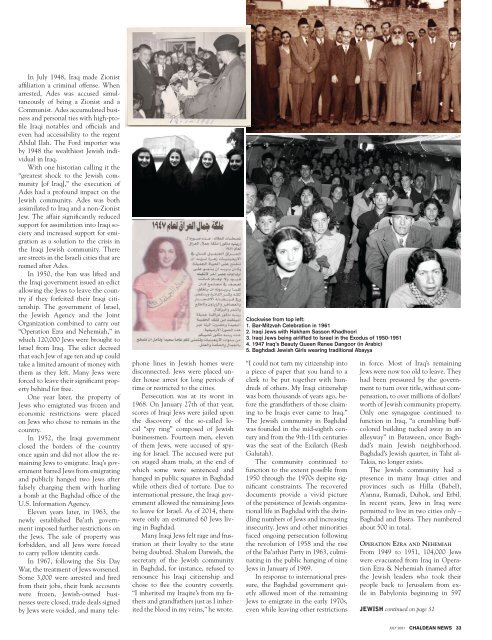JULY 2021
Create successful ePaper yourself
Turn your PDF publications into a flip-book with our unique Google optimized e-Paper software.
In July 1948, Iraq made Zionist<br />
affiliation a criminal offense. When<br />
arrested, Ades was accused simultaneously<br />
of being a Zionist and a<br />
Communist. Ades accumulated business<br />
and personal ties with high-profile<br />
Iraqi notables and officials and<br />
even had accessibility to the regent<br />
Abdul Ilah. The Ford importer was<br />
by 1948 the wealthiest Jewish individual<br />
in Iraq.<br />
With one historian calling it the<br />
“greatest shock to the Jewish community<br />
[of Iraq],” the execution of<br />
Ades had a profound impact on the<br />
Jewish community. Ades was both<br />
assimilated to Iraq and a non-Zionist<br />
Jew. The affair significantly reduced<br />
support for assimilation into Iraqi society<br />
and increased support for emigration<br />
as a solution to the crisis in<br />
the Iraqi Jewish community. There<br />
are streets in the Israeli cities that are<br />
named after Ades.<br />
In 1950, the ban was lifted and<br />
the Iraqi government issued an edict<br />
allowing the Jews to leave the country<br />
if they forfeited their Iraqi citizenship.<br />
The government of Israel,<br />
the Jewish Agency and the Joint<br />
Organization combined to carry out<br />
“Operation Ezra and Nehemiah,” in<br />
which 120,000 Jews were brought to<br />
Israel from Iraq. The edict decreed<br />
that each Jew of age ten and up could<br />
take a limited amount of money with<br />
them as they left. Many Jews were<br />
forced to leave their significant property<br />
behind for free.<br />
One year later, the property of<br />
Jews who emigrated was frozen and<br />
economic restrictions were placed<br />
on Jews who chose to remain in the<br />
country.<br />
In 1952, the Iraqi government<br />
closed the borders of the country<br />
once again and did not allow the remaining<br />
Jews to emigrate. Iraq’s government<br />
barred Jews from emigrating<br />
and publicly hanged two Jews after<br />
falsely charging them with hurling<br />
a bomb at the Baghdad office of the<br />
U.S. Information Agency.<br />
Eleven years later, in 1963, the<br />
newly established Ba’ath government<br />
imposed further restrictions on<br />
the Jews. The sale of property was<br />
forbidden, and all Jews were forced<br />
to carry yellow identity cards.<br />
In 1967, following the Six Day<br />
War, the treatment of Jews worsened.<br />
Some 3,000 were arrested and fired<br />
from their jobs, their bank accounts<br />
were frozen, Jewish-owned businesses<br />
were closed, trade deals signed<br />
by Jews were voided, and many telephone<br />
lines in Jewish homes were<br />
disconnected. Jews were placed under<br />
house arrest for long periods of<br />
time or restricted to the cities.<br />
Persecution was at its worst in<br />
1968. On January 27th of that year,<br />
scores of Iraqi Jews were jailed upon<br />
the discovery of the so-called local<br />
“spy ring” composed of Jewish<br />
businessmen. Fourteen men, eleven<br />
of them Jews, were accused of spying<br />
for Israel. The accused were put<br />
on staged sham trials, at the end of<br />
which some were sentenced and<br />
hanged in public squares in Baghdad<br />
while others died of torture. Due to<br />
international pressure, the Iraqi government<br />
allowed the remaining Jews<br />
to leave for Israel. As of 2014, there<br />
were only an estimated 60 Jews living<br />
in Baghdad.<br />
Many Iraqi Jews felt rage and frustration<br />
at their loyalty to the state<br />
being doubted. Shalom Darwish, the<br />
secretary of the Jewish community<br />
in Baghdad, for instance, refused to<br />
renounce his Iraqi citizenship and<br />
chose to flee the country covertly.<br />
“I inherited my Iraqite’s from my fathers<br />
and grandfathers just as I inherited<br />
the blood in my veins,” he wrote.<br />
Clockwise from top left:<br />
1. Bar-Mitzvah Celebration in 1961<br />
2. Iraqi Jews with Hakham Sasson Khadhoori<br />
3. Iraqi Jews being airlifted to Israel in the Exodus of 1950-1951<br />
4. 1947 Iraq’s Beauty Queen Renee Dangoor (in Arabic)<br />
5. Baghdadi Jewish Girls wearing traditional Abayya<br />
“I could not turn my citizenship into<br />
a piece of paper that you hand to a<br />
clerk to be put together with hundreds<br />
of others. My Iraqi citizenship<br />
was born thousands of years ago, before<br />
the grandfathers of those claiming<br />
to be Iraqis ever came to Iraq.”<br />
The Jewish community in Baghdad<br />
was founded in the mid-eighth century<br />
and from the 9th-11th centuries<br />
was the seat of the Exilarch (Resh<br />
Galutah).<br />
The community continued to<br />
function to the extent possible from<br />
1950 through the 1970s despite significant<br />
constraints. The recovered<br />
documents provide a vivid picture<br />
of the persistence of Jewish organizational<br />
life in Baghdad with the dwindling<br />
numbers of Jews and increasing<br />
insecurity. Jews and other minorities<br />
faced ongoing persecution following<br />
the revolution of 1958 and the rise<br />
of the Ba’athist Party in 1963, culminating<br />
in the public hanging of nine<br />
Jews in January of 1969.<br />
In response to international pressure,<br />
the Baghdad government quietly<br />
allowed most of the remaining<br />
Jews to emigrate in the early 1970s,<br />
even while leaving other restrictions<br />
in force. Most of Iraq’s remaining<br />
Jews were now too old to leave. They<br />
had been pressured by the government<br />
to turn over title, without compensation,<br />
to over millions of dollars’<br />
worth of Jewish community property.<br />
Only one synagogue continued to<br />
function in Iraq, “a crumbling buffcolored<br />
building tucked away in an<br />
alleyway” in Bataween, once Baghdad’s<br />
main Jewish neighborhood.<br />
Baghdad’s Jewish quarter, in Taht al-<br />
Takia, no longer exists.<br />
The Jewish community had a<br />
presence in many Iraqi cities and<br />
provinces such as Hilla (Babel),<br />
A’anna, Rumadi, Duhok, and Erbil.<br />
In recent years, Jews in Iraq were<br />
permitted to live in two cities only –<br />
Baghdad and Basra. They numbered<br />
about 500 in total.<br />
Operation Ezra and Nehemiah<br />
From 1949 to 1951, 104,000 Jews<br />
were evacuated from Iraq in Operation<br />
Ezra & Nehemiah (named after<br />
the Jewish leaders who took their<br />
people back to Jerusalem from exile<br />
in Babylonia beginning in 597<br />
JEWISH continued on page 32<br />
<strong>JULY</strong> <strong>2021</strong> CHALDEAN NEWS 33

















